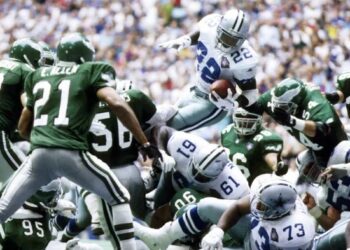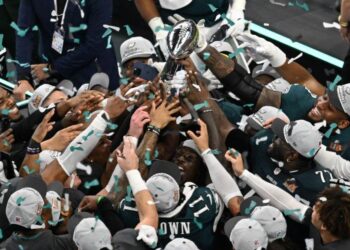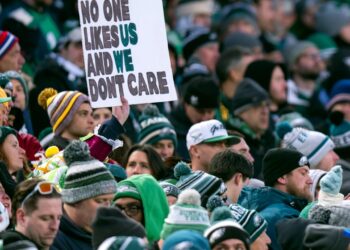By: Thomas Brown
As I take a trip down memory lane, I’ll look at the Eagles’ 2017 season and present how that season can be a blueprint. This list is not in any order but a compilation of ingredients that led to the Lombardi trophy landing in Philadelphia three years ago.
1. An MVP Level Of Play
In 2017, Carson Wentz was en route to winning the MVP trophy until a season-ending injury (Torn ACL/LCL) derailed him. In 13 games, he completed 60.2% of his passes. Wentz also threw for 3,296 yards, 33 touchdowns to just seven interceptions! He was also sacked 28 times and lost the football on only five different instances during that span. Why did I implement that last statistic, you may ask? This past season, Wentz was sacked 37 times and managed to only cough up the football just 6 times. It does not help that future hall-of-fame LT Jason Peters is not back this season to protect Wentz’s blindside either.
With that disclaimer said, Wentz still managed to put on a spectacular showing. The franchise QB completed 63.9% of his passes. He went on to throw for 4,039 yards passing, 27 touchdowns to just seven interceptions! Perhaps the upcoming draft and free agency could help GM Howie Roseman protect Wentz for next season and the foreseeable future.
ADVICE FOR THE UPCOMING SEASON: If Wentz is upright, he can and will handle the rest.
2. The Bevy Of Weapons
In the 2017 regular season, the number of weapons Wentz had was impeccable in several ways. In the running game, there was a two-headed monster in the backfield that included LeGarrette Blount and Jay Ajayi. During the 2017 regular season, they both combined for 1,174 yards rushing (Blount:766, Ajayi: 408) and averaged 4.4 and 5.8 yards per carry respectively. On a side note, the duo only fumbled the football three times too! When the playoffs began, the offense showed more love to Ajayi in terms of carries, but Blount was not far behind. Ajayi ran for 184 yards on 4.4 yards per carry while Blount ran for 130 yards on 4.5 yards per carry to follow suit. 2019, however, was a little bit different.
RB Miles Sanders was the only running back on the roster to finish and play an entire regular season. He had a running mate in Jordan Howard, but unfortunately, injury got in the way. For the sake of the article, I’ll use this duo. On occasions such as this, numbers can be deceiving. Sanders and Howard combined for 1,343 yards rushing (Sanders: 818, Howard: 525) and averaged 4.6 and 4.4 yards per carry respectively. They only managed to fumble twice during the entire season! The downside to these statistics is that while Sanders played the whole season, Howard managed to suit up just ten times. In the lone playoff game against Seattle, the running game was struggling as Sanders and Boston Scott combined for only 94 yards rushing (Sanders: 69, Scott: 25) and averaged 4.9 and 4.2 yards per carry respectively.
ADVICE FOR THE UPCOMING SEASON: If Sanders has another RB that balances the offense through power, it helps EVERYBODY.
3. The Aerial Assault
The Eagles’ receiving core in 2017 made opposing defenses account for every receiver that suited up. These included Zach Ertz, Alshon Jeffery, Nelson Agholar, and Torrey Smith. These receivers collectively made the team reach new heights for an Eagles offense. Ertz led the receiving core in receptions with 74, receiving yards with 824 and had eight touchdowns in that season. Jeffery had 57 catches and 789 receiving yards along with nine touchdowns. Agholar had 62 catches, 768 receiving yards, and eight touchdowns. Smith caught 36 passes for 430 receiving yards along with a pair of touchdowns. In the 2017 postseason, the receiving core combined for 58 receptions, 735 receiving yards, and five touchdowns. The weaponry that was available for Wentz was also available to Nick Foles when the postseason began.
Keep this in mind, the top three positions that led the 2017 Eagles offense in receiving yards were the following: TE, WR, and WR. 2019 was terrible for WR’s. The top three positions that led the Eagles in yards receiving would be TE, TE, and RB. Zach Ertz, Dallas Goddert, and Miles Sanders, in that order, led the Eagles in receiving. Ertz led the receiving core in receptions with 88, 916 yards receiving along with six touchdowns. Goddert had 58 receptions, 607 yards receiving, and also got into the end zone 5 times. Sanders finished the season with 50 catches, 509 yards receiving along with three touchdowns. In the Eagles’ 2019 postseason game, the receiving core combined for 12 catches, 125 receiving yards, and zero touchdowns during that game.
ADVICE FOR THE UPCOMING SEASON: The Offense greatly needs speed at WR and multiple skill sets to keep opposing defenses honest. Free agency and the draft could improve the dynamic of the offense.
4. Top 5 Ranked Defense
In the 2017 regular season, the Eagles ranked 4th in total defense. As a unit led by Jim Schwartz, they tied for 4th in interceptions, allowed 306.5 yards per game, and were in the middle in sacks ranking 15th. Star veterans like DT Fletcher Cox, S Malcolm Jenkins, and DE Brandon Graham served as defensive anchors to hold the defense accountable while setting the example. Graham led the defense in sacks with 9.5. He also had 47 tackles, and 19 of them were for a loss of yardage. He went on to force two fumbles, recover one and return one for a score. Star DT Fletcher Cox had 5.5 sacks along with 26 tackles. He also managed to force a fumble and recover two altogether and returned one for a score. Malcolm Jenkins had 76 tackles, eight passes defended, two interceptions forced and recovered a fumble.
In the 2017 postseason, the Schwartz-led defense ranked 3rd in tackles and interceptions. The star triplets combined for 31 tackles and 5 of those tackles were for lost yardage, two sacks, and one pivotal forced fumble. This past season was simply not the 2017 defense. They ranked 15th in total defense, 19th in pass defense, and managed to rank 3rd in run defense!
ADVICE FOR THE UPCOMING SEASON: Howie Roseman, please, with a cherry on top, please address ALL three levels of this defense in free agency and the draft. The defense needs all the help it can get to improve substantially better heading into the 2020 season.
Links:
https://www.espn.com/nfl/team/stats/_/name/phi/season/2019/seasontype/2/table/passing/sort/passingYards/dir/desc
https://www.pro-football-reference.com/teams/phi/2019.htm


 NFL
NFL






Wow! Excellent article! I agree, there is so much potential in having a great defense this coming season!